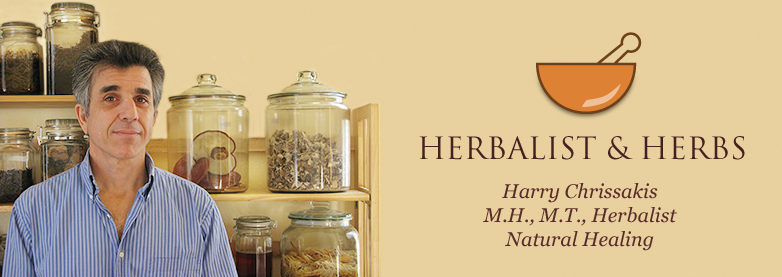HERBS TO TREAT COUGHS AND COLDS by Harry Chrissakis Herbalist, M.H. Natural Healing
HERBALIST AND HERBS
When the seasons change there is a period of adjustment in
the body’s energy. Due to this shift there is a vulnerability to
external factors such as cold and wetness as well as pathogenic
bacteria and viruses.
Although a number of these herbs are considered anti-viral
some of the heavies in the herbal world contend that that’s
not true at all. That in fact what they do is either to get your
body to fight better and faster (immunostimulants) or to create
an environment that makes it hard for the critters to
multiply and have a party at your expense. Whatever the reason,
they do work.
One crucial thing about herbs is that they do not have the
distance that drugs do. So you must apply them more often
and work with a cold more aggressively dosing yourself 5-7x
a day. If you catch colds early enough (given that the person
has a reasonably good constitution) you can stop it quickly
and never get knocked down.
Let’s watch a short introductory video:
These herbs work well alone but are even better in combination.
However keep it simple and if you create a formula do it with no more than 2-4 herbs.
These herbs are for acute problems and not for long term use
— maximum 3 weeks. Longer use without supervision is not a
good idea because they usually push the body, eventually
undermining your defensive energy (the Chinese call it
“breaking chi”).
Let’s start with immunostimulants — things
that kick up an immune reaction.
ECHINACEA PURPUREA. The pop herb of the last decade
— it really deserves its reputation. This is one of the few
immuno-stimulants (high dose – short term) that’s also an
immunotonic (low dose – long term). Relatively high doses,
1-2 dropperfuls multiple times a day kicks up the immune
function in the lungs and works with acute problems such as
coughs and colds. For lungs that have been weakened by long
term stress or bouts of pneumonia, extended use of echinacea
will improve overall function. Good to combine with a lung
tonic such as astragalus.
OSHA. This is a strong lung stimulant good for onset creating
such a strong response that colds never happen. Not good to
use once a cold has established itself with some form of bronchial
inflammation as the stimulating qualities will further
irritate the tissue. It is a good gargle for sore throats as it has
analgesic properties (stops pain). Both osha and echinacea
were introduced to white settlers by native Americans.
LOMATIUM. Not well known but really excellent for
coughs, colds and flus. Lomatium was introduced to the US
pharmacopoeia in 1940 by Percy Train. During the flu of
1920-22, those using lomatium were spared their lives while
those untreated died in large numbers; many healthy people
dying within 5 days of onset. It is hard to get a handle on this
kind of devastation by a microbe. I’m going to give you
another example of the capability of viral flus. The Spanish
flu of 1918-20 killed a low estimate of 40 million people
worldwide. This pandemic burned itself out in 2 years killing
1 member of every 10 families in the U.S. alone. Amazing
and somewhat scary. Lomatium is also good in the treatment
of viral or bacterial pneumonia and to help reduce runaway
fevers. It really is a herb with brilliant capabilities.
To the first 3 immunostimulants I will now add some herbs
to bring down cough (antitussives) and soothe abraded or
irritated tissue (demulcent).
GRINDELIA. A local plant that grows all over the foothills,
grindelia is a moistening expectorant and a very good stopcough
remedy. Good for a dry, raspy cough and to help stop
that throat tickle that is the beginning of a spasmodic cough
that hurts the lungs and chest. Good as tea or tincture.
LICORICE. Another moistening, expectorant, antitussive.
The new thing is to remove the glycyrrhizan out of licorice
because it tends to raise blood pressure by increasing blood
volume and it will do this long term. But in application to
acute problems it is safe and effective. Glycyrrhizan is one of
its major constituents and has a lot to do with healing tissue
that has been abraded by hacking coughs. Licorice’s healing
virtues extend far beyond colds and coughs. It is a main constituent
of hundreds of Chinese formulas — from the treatment
of stomach ulcers to rebuilding exhausted adrenals.
PERILLA LEAF. Used to color that pink ginger you get with
sushi (it’s also good for seafood poisoning) perilla is an excellent
antitussive tea or tincture.
THYME. This common spice is a great stop cough remedy and
a good anti-microbial. Dr. Rudolf Weiss (wrote the definitive
text for German herbal medicine) recommends it as the premier
herb for the treatment of whopping cough in children.
Two prepared herbal formulas from the Chinese are
YINCHIAO and GANMAOLING. Both come in pill form,
both work best at the beginning stages of a cold. Once the
cold has set in you will need something stronger from the
group of previously mentioned herbs.
Harry Chrissakis Herbalist, M.H., Natural Healing.
ww.Herbalist and Herbs.com
contact@herbalist-herbs.com
530-933-8244
